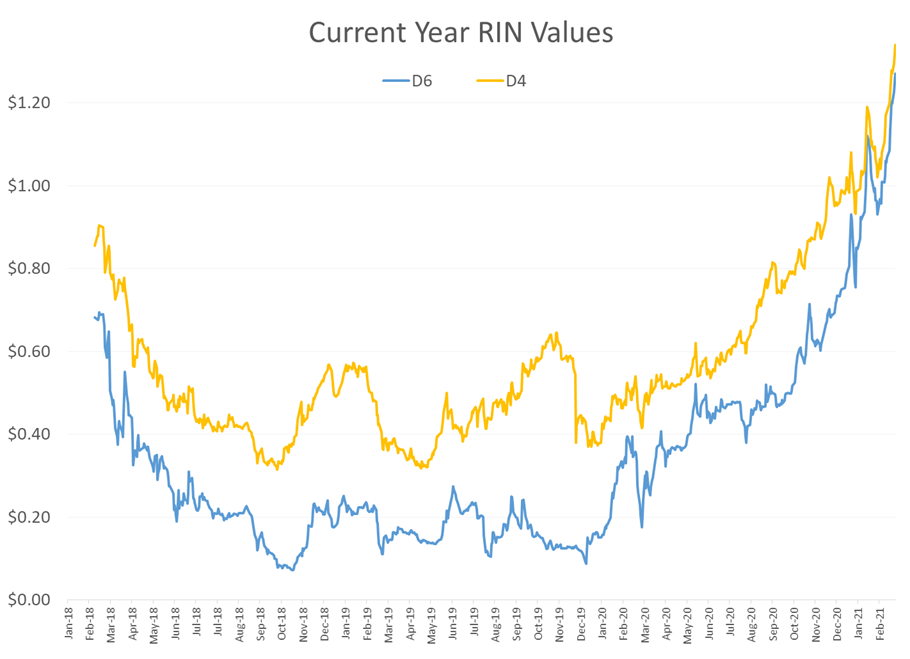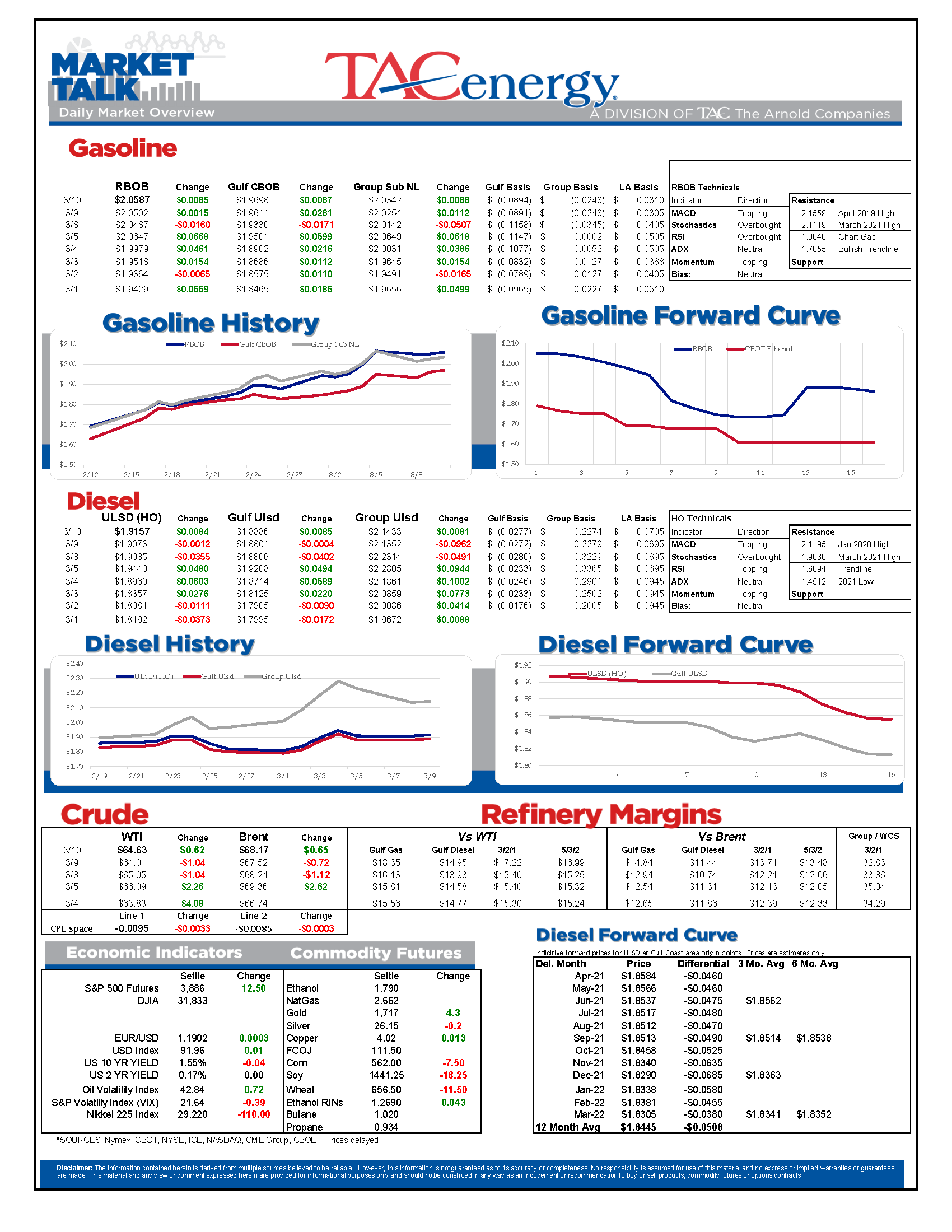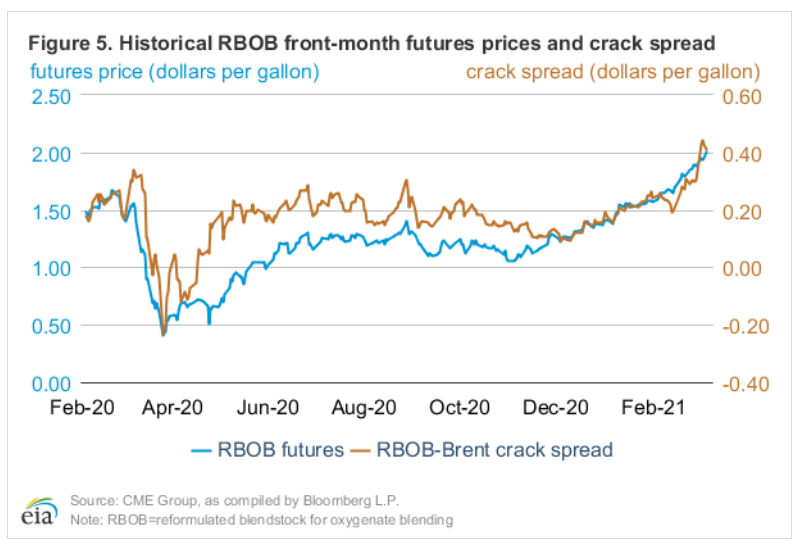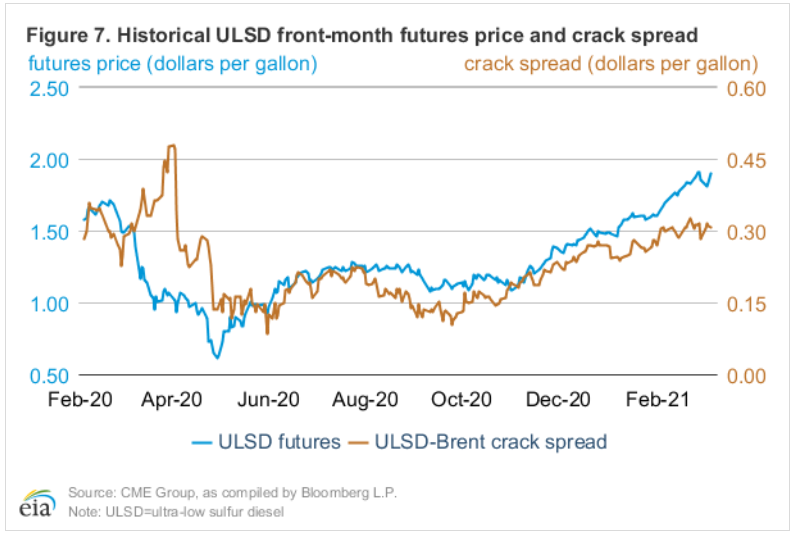Long String Of Price Bounces

Energy futures survived yet another attempted selloff overnight, with refined products trading up modestly this morning after moving lower by around three cents overnight. The latest in a long string of price bounces continues to encourage the “buy the dip” crowd, and keeps the bullish trend intact for now.
The EIA’s short term energy outlook raised the expectations for U.S. GDP growth in 2021 by 1.7%, as the economy is now expected to recover at a much faster rate than was predicted just a month ago. Despite the increase in growth, the EIA still predicts that global oil supply growth will outpace demand in the back half of the year as idle capacity is brought back online around the globe. The STEO highlighted the role a weaker U.S. dollar has played in oil prices rising over the past several months, failing to explain why priced have continued to go up even as the dollar has surged in recent weeks.
The analysts also mentioned the rally in refinery margins, but failed to note the relationship that near-record RIN prices may be having on those spreads, and instead blamed it on “expectations of higher gasoline demand and subdued supply, likely contributed.” In other words, they don’t really watch the market much at all. One interesting piece of data aided by the dramatic refining impacts of February’s polar plunge, was that “the United States will be a net importer of 0.2 million b/d of gasoline in March, which would be the first time the United States is a net importer of gasoline in March since 2015.”
The API reported some huge figures in its weekly inventory report, as the industry group’s estimates catch up to the record-setting DOE data we saw a week ago, and numerous refinery issues continue to linger. Crude supplies were reported to increase by 12.8 million barrels on the week while gasoline stocks declined by 8.5 million barrels and distillates dropped by 3.8 million. The DOE’s weekly report is due out at its normal time this morning and we “should” see a bounce back in refinery runs after they smashed the record for lowest run rate percentage last week, but it’s hard to say by how much given the various false-starts reported as plants started coming back online. A Bloomberg report said that as of Monday, just 7 of the 18 refineries shuttered by the February cold snap are operating normally.
Diesel basis values are starting to return to normal amidst signs that the worst of the supply squeeze is behind us. Group 3 ULSD basis values in particular began their return trip to earth, dropping 20 cents so far this week from Friday’s high trade, but still commanding a healthy premium to neighboring markets as inventories in the region remain tight. Even as the panic buying appears to have subsided, ULSD supply continues to be tight across many U.S. markets. Short term runouts are still expected across the South and up the East Coast over the next week because Colonial pipeline still doesn’t have enough push stock coming from the Houston area to run the pipeline at full rates.
Unfortunately Colonial Pipeline is making headlines for other reasons this week as reports about last year’s gasoline leak in North Carolina reveal that the spill was much larger than originally reported, and was in fact one of the largest spills on record. Numerous follow up reports are coming out trying to explain how that could happen, while the risks of an old pipeline being so critical to the country’s fuel supply have been known in the industry for years. One interesting note is that reports suggest the pipeline is using the current slow shipping environment to perform maintenance on parts of the line that would be more challenging – if not impossible – when the line is running at capacity.
Today’s interesting read: Why it pays to know your counterparty in commodity markets.
Click here to download a PDF of today's TACenergy Market Talk.
Latest Posts
Crude Oil Inventories Climbed Above Year-Ago Levels For The First Time In 2024
Week 17 - US DOE Inventory Recap
The Energy Complex Is Trading Modestly Lower So Far This Morning With WTI Crude Oil Futures Leading The Way
Energy Futures Are Drifting Quietly Higher This Morning
Social Media
News & Views
View All
Crude Oil Inventories Climbed Above Year-Ago Levels For The First Time In 2024
Sell by May then go away.
The old trading adage looked good for energy markets in 2024 as the new month started off with the biggest daily sell-off of the year so far. WTI and ULSD contracts are now in “rally or else” mode on the charts with sharply lower prices a strong possibility now that technical support layers have broken down. RBOB doesn’t look quite as bearish on the charts, but seasonal factors will now act as a headwind as we’re well into the spring peaking window for gasoline prices, and we’ve already seen a 27 cent drop from the highs. If RBOB can hold above $2.50 there’s a chance to avoid a larger selloff, but if not, a run towards $2.20 for both gasoline and diesel looks likely in the months ahead.
The selling picked up steam following the DOE’s weekly report Wednesday, even though the inventory changes were fairly small. Crude oil inventories continue their steady build and climbed above year-ago levels for the first time in 2024. Demand for refined products remains sluggish, even after accounting for the RD consumption that’s still not in the weekly reports, and most PADDs are following a typical seasonal inventory trend. The Gulf Coast saw a healthy build in diesel inventories last week as the export market slowed for a 3rd straight week. Refinery runs dipped modestly last week following a handful of upsets across the country, but overall rates remain near normal levels for this time of year.
The Transmountain pipeline expansion began operations yesterday, completing a 12-year saga that has the potential to materially change refining economics for plants in the US that relied heavily on discounted Canadian crude to turn profits over the past decade.
The P66 Borger refinery reported another operational upset Monday that lasted a full 24 hours impacting a sulfur recovery unit. Last week the company highlighted how the plant’s fire department helped the surrounding area when the largest wildfire in state history came within feet of the facility.
The EPA approved a new model to determine life cycle carbon intensity scores this week, which cracks open the door for things like ethanol to SAF, which were previously deemed to not reduce emissions enough to qualify for government subsidies. The new model would require improved farming techniques like no-till, cover crop planting and using higher efficiency nitrogen fertilizer to limit the damage done by farms that no longer rotate crops due to the ethanol mandates. Whether or not the theoretical ability to produce SAF comes to fruition in the coming years thanks to the increased tax credit potential will be a key pivot point for some markets that find themselves with too much RD today, but could see those supplies transition to aviation demand.
The FED continues to throw cold water on anyone hoping for a near term cut in interest rates. The FOMC held rates steady as expected Wednesday, but also highlighted the struggles with stubbornly high inflation. The CME’s Fedwatch tool gave 58% odds of at least one rate cut by September before the announcement, and those odds have slipped modestly to 54% this morning.

Week 17 - US DOE Inventory Recap

The Energy Complex Is Trading Modestly Lower So Far This Morning With WTI Crude Oil Futures Leading The Way
The energy complex is trading modestly lower so far this morning with WTI crude oil futures leading the way, exchanging hands $1.50 per barrel lower (-1.9%) than Tuesday’s settlement price. Gasoline and diesel futures are following suit, dropping .0390 and .0280 per gallon, respectively.
A surprise crude oil build (one that doesn’t include any changes to the SPR) as reported by the American Petroleum Institute late Tuesday is taking credit for the bearish trading seen this morning. The Institute estimated an increase in crude inventories of ~5 million barrels and drop in both refined product stocks of 1.5-2.2 million barrels for the week ending April 26. The Department of Energy’s official report is due out at it’s regular time (9:30 CDT) this morning.
The Senate Budget Committee is scheduled to hold a hearing at 9:00 AM EST this morning regarding a years-long probe into climate change messaging from big oil companies. Following a 3-year investigation, Senate and House Democrats released their final report yesterday alleging major oil companies have internally recognized the impacts of fossil fuels on the climate since as far back as the 1960s, while privately lobbying against climate legislation and publicly presenting a narrative that undermines a connection between the two. Whether this will have a tangible effect on policy or is just the latest announcement in an election-yeardeluge is yet to be seen.
Speaking of deluge, another drone attack was launched against Russian infrastructure earlier this morning, causing an explosion and subsequent fire at Rosneft’s Ryazan refinery. While likely a response to the five killed from Russian missile strikes in Odesa and Kharkiv, Kyiv has yet to officially claim responsibility for the attack that successfully struck state infrastructure just 130 miles from Moscow.
The crude oil bears are on a tear this past week, blowing past WTI’s 5 and 10 day moving averages on Monday and opening below it’s 50-day MA this morning. The $80 level is likely a key resistance level, below which the path is open for the American oil benchmark to drop to the $75 level in short order.
Click here to download a PDF of today's TACenergy Market Talk.




